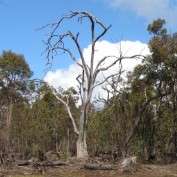A jarrah forest impacted by dieback
Murdoch University researchers have developed a model which shows the devastating plant pathogen Phytophthora cinnamomi could be distributed more widely in Australia and around the globe than previously thought.
The methods used to develop and test the model have also shown for the first time that P. cinnamomi occurs at higher elevations in eastern Australia and central Tasmania.
The pathogen's DNA was detected by the research team in soil samples taken from these sub-alpine regions.
The pathogen can lead to susceptible plants developing the deadly Phytophthora dieback disease in the suitable environmental conditions of a warm, wet winter, followed by a dry summer.
The disease causes root rot, limiting or stopping the uptake of water and nutrients into the plant. The pathogen is also able to survive within plant roots during the dry soil conditions commonly experienced during the summer months.
Associate Professor Treena Burgess from the Centre for Phytophthora Science and Management at Murdoch, who led the research, said the detection of the pathogen's DNA in Tasmanian and eastern Australian soils was "concerning".
"Currently, the environment there is not conducive for the dieback disease to develop in susceptible plant species, but it is important that land managers are prepared," she said.
"They should apply strict hygiene at all access points to regions where the pathogen has been found, especially along walking tracks. Signage and boot cleaning stations are methods that have been used successfully to help contain the disease in south west Australia, where dieback is widespread."
Use of the model, developed at Murdoch, has identified that much of mainland China, Laos, Thailand and Southern Sweden have suitable climatic conditions for P.cinnamomi.
The model was developed based on the pathogen's response to temperature and moisture, and by incorporating evidence of its presence or absence from certain areas.
Professor Burgess said it was useful to predict parts of the world where P. cinnamomi might occur now and in the future.
"This will enable preventative measures, such as community education and cleaning stations, as well as thorough sampling, to be implemented," she said. "We hope our mapping will provide the basis for more detailed regional scale modelling to help governments and land owners effectively plan management of the pathogen."
In their paper for the journal Global Change Biology, Professor Burgess and her team also used their model to project the distribution of the pathogen in the year 2080.
They found that climate change is likely to mean areas currently most impacted by the dieback disease, like the south west of WA and the Cape region of South Africa, will become less suitable for the pathogen.
However, the sub alpine regions of Australia where previously cold stress has restricted disease development, could become more suitable.
More information: Treena I. Burgess et al. Current and projected global distribution of, one of the world's worst plant pathogens, Global Change Biology (2016). DOI: 10.1111/gcb.13492
Journal information: Global Change Biology
Provided by Murdoch University
























